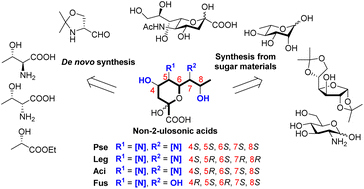Recent progress on the chemical synthesis of bacterial non-2-ulosonic acids†
Abstract
Bacteria resistant to antibiotics present a threat to public health. The bacterial non-2-ulosonic acids, including pseudaminic acid, legionaminic acid, acinetaminic acid, fusaminic acid, and several of their epimers, have been identified from the pathogenic Gram-negative bacteria, which have been proposed to associate with bacterial infection/pathogenicity, immune escape, and so on. The intriguing structures and less-understood biological functions make them attractive synthetic targets for biological studies and drug discovery. In this review, the chemical syntheses of four types of non-2-ulosonic acid structures that were reported in the past two decades are summarised, together with recent progress on the application of synthetic non-2-ulosonic acid derivatives.

- This article is part of the themed collections: 2023 Organic Chemistry Frontiers HOT articles and 2023 Organic Chemistry Frontiers Review-type Articles


 Please wait while we load your content...
Please wait while we load your content...